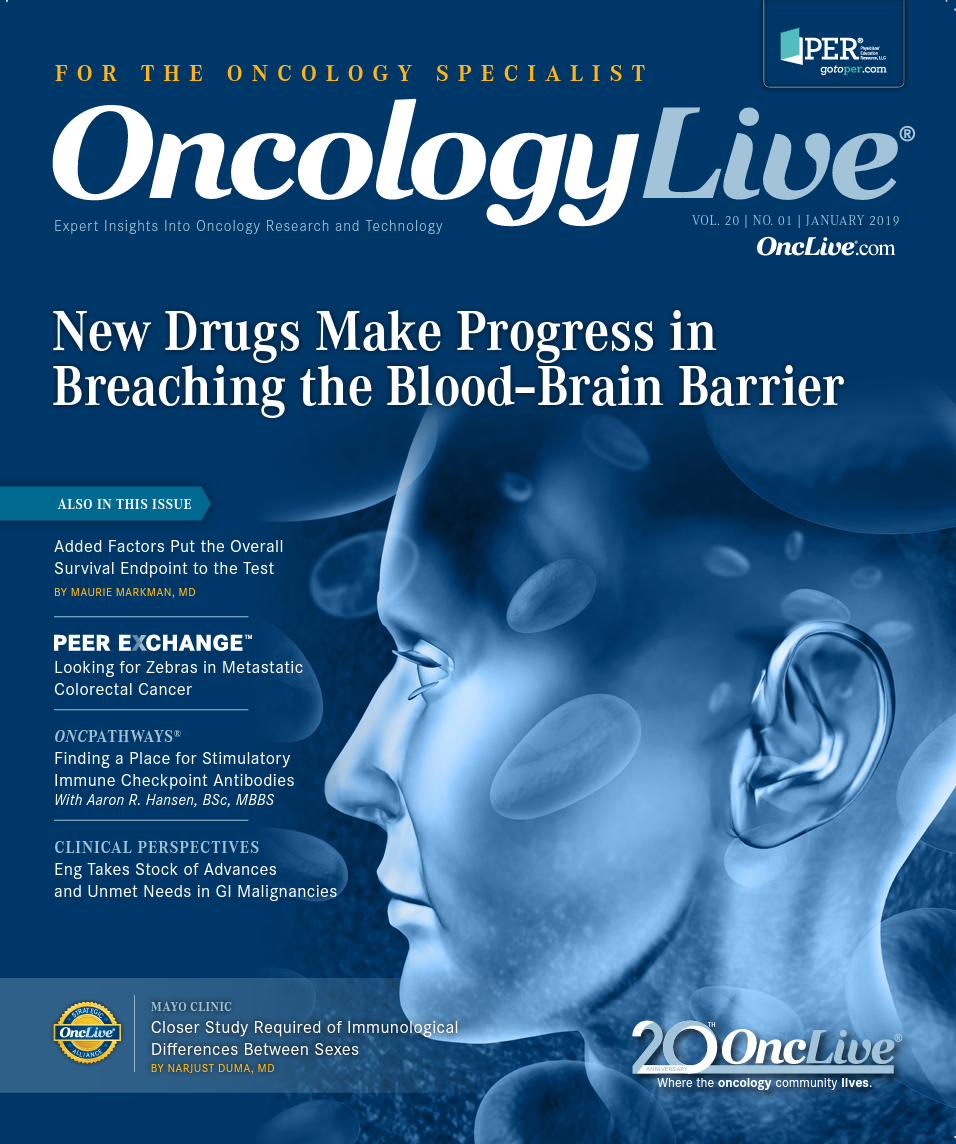Checkpoint Inhibitors Herald New Era in Urothelial Cancer
Immune checkpoint inhibitors, with their favorable safety and antitumor activity profiles, have heralded a new era in urothelial carcinoma treatment.

Petros Grivas, MD
Bladder cancer is very common and can cause significant morbidity, mortality, emotional distress, and financial burden for patients, families, societies, and healthcare systems worldwide. The most common histologic type is urothelial carcinoma (UC), which can affect the renal pelvis, ureter, bladder (most common site), and urethra. Long-term survival rates for locally advanced (with extravesical and/ or node-positive disease) and metastatic disease remain dismal, with an overall survival (OS) of 9 to 15 months and 5-year OS rate of 5% for metastatic cancer, even with platinum-based chemotherapy, which is the standard of care. The entire disease spectrum requires the development of new agents that are feasible and can improve outcomes. In that context, immune checkpoint inhibitors (ICIs), with their favorable safety and antitumor activity profiles, have heralded a new era in UC treatment.
The primary molecular targets for ICIs are PD-1, PD-L1, and CTLA-4 checkpoints, which act as coinhibitory signals blocking antitumor effector T-cell responses, thereby downregulating antitumor response.1 PD-1 is a transmembrane protein expressed on activated T cells that interacts with PD-L1 (B7-H1 or CD274), which is expressed on antigen-presenting cells and many types of tumor cells.2,3 This interaction leads to suppression of T-cell receptor—mediated effector functions and inhibits proliferation of antigen-specific CD8-positive T cells.3 Cells of immunologically responsive tumors often up-regulate PD-L1 expression, thereby facilitating immune escape. By blocking either PD-1 or PD-L1, ICIs reinvigorate antitumor T-cell-mediated immune responses.4
CTLA-4 is structurally related to CD28, a costimulatory signal that plays a vital role in T-cell activation.5 By competitively binding to its ligands B7.1 and B7.2, CTLA-4 blocks CD28-mediated costimulatory signaling and thus inhibits T-cell activation.6,7 ICIs that block CTLA-4 will thus lead to reactivation of antitumor effector T-cell response mechanisms.8
Nonmuscle-Invasive Bladder Cancer
A plethora of clinical trials employing ICIs and targeted agents against related immune pathways are ongoing in diverse UC spaces and treatment settings. Below are updates in the development of ICIs across UC treatment settings; however, because data emergence is very dynamic and continuous in this research field, this is not a comprehensive list.The International Bladder Cancer Group has developed refined recommendations on definitions, endpoints, and clinical trial designs for nonmuscle-invasive bladder cancer (NMIBC) to support alignment and harmonization across clinical trials.9 These guidelines also provide a conceptual framework regarding the use of comparator arms and time points for assessment in the settings of Bacillus Calmette—Guérin (BCG)–naïve, BCG-relapsing, and BCG-unresponsive disease.
Perioperative Treatment of Localized MIBC
There are a number of ongoing clinical trials across those sub-settings. The phase II, open-label, KEYNOTE057 trial reported initial results in 103 patients treated with single-agent pembrolizumab (Keytruda; anti—PD-1) with a median follow up of 14 months showing a complete response (CR) rate of 39% in BCG-unresponsive carcinoma in situ (cohort A with or without papillary tumors, despite adequate BCG treatment course).10 The median time to CR was 12.4 weeks (95% CI, 10.4-19.3), and almost three-quarters of patients had ongoing response at the last follow-up; no patient had developed muscle-invasive or metastatic disease. Those were patients who either refused or were ineligible for radical cystectomy, which is still the standard of care in BCG-unresponsive NMIBC; there was no new safety signal in this trial and the adverse event (AE) profile was consistent with data in advanced UC. These data are very promising but not currently practice-changing; longer follow-up and data from more patients in this and other trials are pending.Neoadjuvant cisplatin-based chemotherapy is currently the standard of care with level I evidence and should be offered to cisplatin-eligible patients with resectable/ operable MIBC. However, many patients may not be able to receive cisplatin due to medical comorbidities, poor performance status, or both, and not every patient derives clinical benefit; therefore, new agents are being investigated. In that context, recent data show very promising pathologic complete response (pCR) rates with singleagent checkpoint inhibition in the neoadjuvant setting before radical cystectomy and pelvic lymph node dissection, supporting further clinical trials in the perioperative and nonmuscle invasive disease settings. The ABACUS neoadjuvant trial showed pCR rate of 29% after 2 doses of atezolizumab (Tecentriq; anti—PD-L1) given every 3 weeks in 68 cisplatin-ineligible patients, with an even higher pCR rate in patients with higher tumor tissue PD-L1 expression; interesting additional biomarker exploration was also pursued.11
The PURE-01 trial had a 42% pCR rate in 50 patients (92% cisplatin-eligible) and identified potential biomarkers for patient selection, such as tumor tissue PD-L1 expression, tumor mutational burden, as well as alterations in Rb1 and DNA damage response genes.12 Moreover, another neoadjuvant trial evaluated the combination of pembrolizumab combined with gemcitabine/cisplatin in 40 patients and showed the rate of ≤ypT1N0 (nonmuscle-invasive downstaging) was 61%, and disease-specific survival, 90%, with longer follow-up required.13 Responses occurred in patients with PD-L1negative and PD-L1—positive tumors; the combination was tolerated with a manageable toxicity profile consistent with previously reported results.
Advanced UC
The recent data described here are very promising but not practice-changing yet. There are several other clinical trials in the neoadjuvant setting evaluating ICIs as single agents and in combination with other agents. There are also 3 ongoing, large, randomized, phase III trials in the adjuvant setting evaluating the role of single agent checkpoint inhibition, while the SN1806 trial is assessing concurrent chemoradiation with or without atezolizumab as definitive locoregional therapy. This trial is expected to launch soon.Platinum-based chemotherapy (ideally cisplatin, or carboplatin in cisplatin-unfit patients) has long been the standard of care in locally advanced/ unresectable and metastatic UC. However, longterm outcomes have largely remained poor, and performance status, organ function, and medical comorbidities often limit the use of chemotherapy. ICIs with their favorable toxicity profiles and notable antitumor activity have ushered in a new era in the treatment of advanced UC, with 5 agents (pembrolizumab, atezolizumab, nivolumab [Opdivo], durvalumab [Imfinzi], and avelumab [Bavencio]) targeting the PD-1/PD-L1 pathway approved by the FDA in the platinum- refractory setting regardless of PD-L1 status.14 Moreover, 2 ICIs (pembrolizumab, atezolizumab) have received FDA and European Medicines Agency approval for frontline treatment of cisplatin-unfit patients who have not received chemotherapy for advanced UC and have “high PD-L1 status” in tumor tissue based on the corresponding companion immunohistochemistry assay (carboplatin-unfit patients do not require PD-L1 testing based on the FDA label).14
Several ongoing clinical trials in advanced UC (upper and lower urinary tract) are evaluating numerous combinations of ICIs and other agents, including 4 large phase III trials in the frontline setting, 2 large switch maintenance trials after frontline therapy, as well as many trials in the salvage (platinum-refractory and/ or ICI-refractory) setting. A recently presented trial evaluating the combination of ipilimumab (Yervoy), a CTLA-4 inhibitor, 3 mg/kg with nivolumab, a PD-1 inhibitor, 1 mg/kg reported a confirmed response rate of 38% (including 6.5% CR) in 92 pretreated patients, with a median time to response of 1.4 months and 30% median tumor size reduction from baseline.15 The combination was feasible and supported an ongoing phase III trial in the frontline setting. Novel combinations with various treatment modalities and optimal sequencing of active therapies are being investigated in prospective clinical trials and retrospective registries. Clinical trial accrual is critical.
Although they reactivate antitumor immunity, ICIs may cause a unique constellation of immune-related AEs, which may warrant discontinuation of therapy and potential use of immunosuppression. Patient education, awareness, and early AE recognition can contribute to proper management. In the era of precision “molecular” oncology, and because patients do not respond uniformly to these agents, there is a growing need for identification and validation of biomarkers that can accurately predict treatment response and assist in optimal patient selection. Validation of putative biomarkers associated with promising results is being pursued in ongoing clinical trials and translational mechanistic studies.
References
- Buchbinder EI, Desai A. CTLA-4 and PD-1 pathways: similarities, differences, and implications of their inhibition. Am J Clin Oncol. 2016;39(1):98-106. doi: 10.1097/COC.0000000000000239.
- Boussiotis VA. Molecular and biochemical aspects of the PD-1 checkpoint pathway. N Engl J Med. 2016;375(18):1767-1778. doi: 10.1056/NEJMra1514296.
- Brown JA, Dorfman DM, Ma FR, et al. Blockade of programmed death-1 ligands on dendritic cells enhances T cell activation and cytokine production. J Immunol. 2003;170(3):1257-1266. doi: 10.4049/jimmunol.170.3.1257.
- Sundararajan S, Vogelzang NJ. Anti-PD-1 and PD-L1 therapy for bladder cancer: what is on the horizon? Future Oncol. 2015;11(16):2299-2306. doi: 10.2217/fon.15.162.
- Linsley PS, Ledbetter JA. The role of the CD28 receptor during T cell responses to antigen. Annu Rev Immunol. 1993;11:191-212. doi: 10.1146/ annurev.iy.11.040193.001203.
- van der Merwe PA, Bodian DL, Daenke S, Linsley P, Davis SJ. CD80 (B7-1) binds both CD28 and CTLA-4 with a low affinity and very fast kinetics. J Exp Med. 1997;185(3):393-403.
- Carreno BM, Bennett F, Chau TA, et al. CTLA-4 (CD152) can inhibit T cell activation by two different mechanisms depending on its level of cell surface expression. J Immunol. 2000;165(3):1352-1356. doi: 10.4049/jimmunol.165.3.1352.
- Peggs KS, Quezada SA, Chambers CA, Korman AJ, Allison JP. Blockade of CTLA4 on both effector and regulatory T cell compartments contributes to the antitumor activity of anti-CTLA-4 antibodies. J Exp Med. 2009;206(8):1717-1725. doi: 10.1084/jem.20082492.
- Kamat AM, Sylvester RJ, Böhle A, et al. Definitions, end points, and clinical trial designs for N=non-muscle-invasive bladder cancer: recommendations from the international bladder cancer group. J Clin Oncol. 2016;34(16):1935-1944. doi: 10.1200/JCO.2015.64.4070.
- De Wit R, Kularni G, Uchio E, et al. Pembrolizumab for high-risk non—muscle invasive bladder cancer (NMIBC) unresponsive to Bacillus Calmette-Guérin: results from an interim analysis of KEYNOTE-057. Presented at: 2018 ESMO Congress; October 19-23, 2018; Munich, Germany. Abstract 864O.
- Powles T, Rodriguez-Vida A, Dran I, et al. A phase II study investigating the safety and efficacy of neoadjuvant atezolizumab in muscle invasive bladder cancer (ABACUS). Presented at: 2018 ASCO Annual Meeting; June 1-5, 2018; Chicago, IL. Abstract 4506. meetinglibrary.asco.org/record/161837/abstract.
- Necchi A, et al. Comprehensive biomarker analyses and updated results of PURE-01 study: neoadjuvant pembrolizumab (Pembro) in muscle-invasive urothelial bladder carcinoma (MIBC). Presented at: 2018 ESMO Congress; October 1923, 2018; Munich, Germany. Abstract 866.
- Hoimes CJ, et al. A phase 1b/2 multicenter study of neoadjuvant pembrolizumab and chemotherapy for locally advanced urothelial cancer (NCT02365766). Presented at: 2018 ESMO Congress; October 19-23, 2018; Munich, Germany. Abstract LBA33.
- Gopalakrishnan D, Koshkin VS, Ornstein MC, Papatsoris A, Grivas P. Immune checkpoint inhibitors in urothelial cancer: recent updates and future outlook. Ther Clin Risk Manag. 2018;14:1019-1040. doi: 10.2147/TCRM.S158753.
- Rosenberg JE, et al. Nivolumab alone or in combination with ipilimumab in patients with platinum-pretreated metastatic urothelial carcinoma, including the nivolumab 1 mg/kg + ipilimumab 3 mg/kg expansion from CheckMate 032. Presented at: 2018 ESMO Congress; October 19-23, 2018; Munich, Germany. Abstract LBA32.




